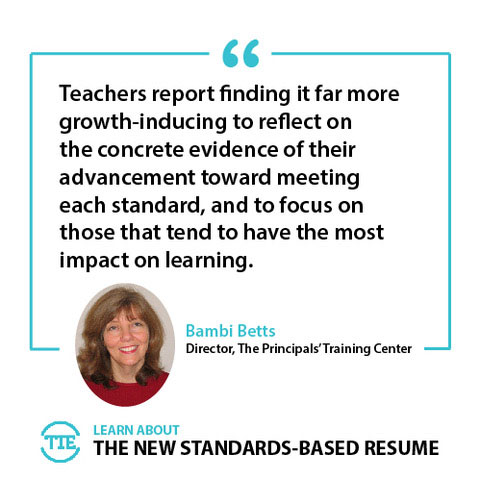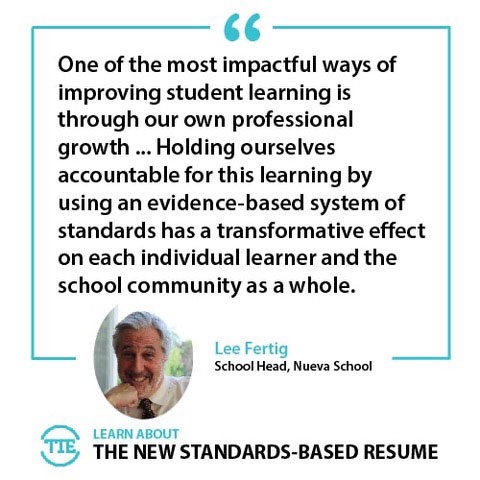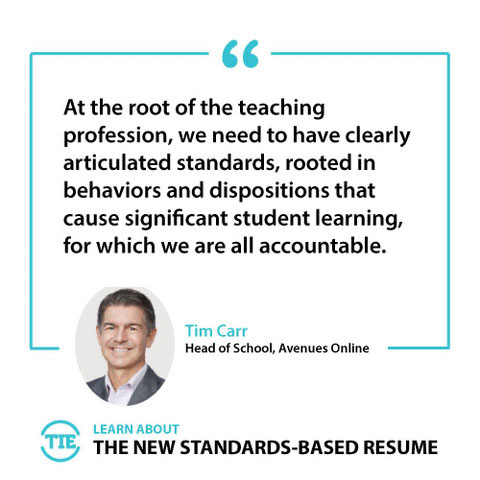International school leaders are ever earnestly in search of tools and processes that will keep the school focused on student learning. This is a tough assignment when traditional tools—from recruitment to teacher evaluation to student assessment—perpetually compete for our attention. So where do we look, and how will we know which of those resources will make the most difference to learning?
A promising place to start
Educational research across the board points to quality of teaching as the number one school-based factor contributing to learning. When school leaders set high standards for teaching and rigorously monitor progress toward achieving them, more and better learning happens. And an additional huge benefit? They reaffirm that teaching is a profession, a concept that is sometimes on shaky ground. Because that’s what professions do—they set standards, raise them as new knowledge and understandings emerge from research and practice, and hold themselves to those standards through genuine, systematic processes.
Uniquely international standards
The notion of professional standards is clearly not new. Individual countries and school systems do set expectations and collect and use data on them in a variety of ways. But what about international schools?
Do their specific context and circumstances warrant a close look? The consensus is a resounding ‘yes’.
The notion of establishing standards for international educators has been gathering momentum for close to two decades now, with the guidance and initiative of researchers such as James Stronge and collaborators such as the Academy for International School Heads (AISH), the Principals’ Training Center (PTC), and The International Educator (TIE) itself. Support for standards among these organizations is now well-established, as is visible on all of their websites.
International teacher standards reflect not only the research-based universal standards that define the profession but additionally include lenses unique to the international school context, such as:
- Model the skills and attitudes of global citizenship, antiracism and intercultural sensitivity and proactivity.
- Support learning in a culture of transition and mobility.
- Meet the learning needs of learners with diverse language backgrounds in the mainstream classroom.
What does it look like when standards serve as drivers?
Standards for teaching describe what an effective teacher who is routinely “causing learning” should aspire to embody; the international lenses refine and enhance what ‘effective’ looks like in international schools.
Enlightened school leaders will understand these standards, however, not as end points but rather as growth pathways. Standards on their own, disconnected from key processes and protocols in the school, run the risk of becoming shelved expectations. It is only when they form the foundation for all facets of ensuring teacher quality—recruitment, professional learning, appraisal, coaching—that we begin to harness their power as catalysts for impact on learning.
Progress!
We are beginning to see encouraging signs related to the positive use and effect of international teacher standards in the international school context.
- TIE’s new recruitment services model provides a strong example. Rather than the traditional resume, the job-seeker creates a portfolio-based resume based on the international teacher standards, uploading evidence of how they have achieved each standard. The confidential statement of recommendation by a supervisor uses the same standards-based approach. This alignment of key recruitment tools serves to keep both the job seeker and the recruiter focused on the practices that we know will make a difference to learning.
- Principals and teacher leaders involved in supervision and appraisal processes report that “hard conversations” become far more productive when the dialogue can emanate from a standards-based question—i.e., “Lets’ talk about standard two and the progress you are making on that front”—rather than being prompted by a regrettable episode.
- Increasingly, decisions about professional learning are personalized and tailored starting with the standards.
- Teachers themselves report finding it far more growth-inducing to reflect on the concrete evidence of their advancement toward meeting each standard, and to focus on those that tend to have the most impact on learning.
Standards for teachers is not a new idea. Standards for teachers reflecting the unique international needs? Gathering steam. What is new? Truly using them as drivers for learning by fully aligning these measures with all the tools in the professional toolbox for finding and keeping an outstanding teacher in every classroom every day.
Partners & Collaborators on the Standards of Practice for International Schools

Standards of Practice for the International Teacher
1. Effectively apply the most up-to-date, research-based strategies to address the needs of diverse learners.
2. Model the skills and attitudes of global citizenship, antiracism and intercultural sensitivity and proactivity.
3. Support learning in a culture of transition and mobility.
4. Collaborate positively with all members of the school community (student, colleagues, parents, leaders).
5. Meet the learning needs of learners with diverse language backgrounds in the mainstream classroom.
6. Skillfully and positively contribute to the curriculum development and monitoring processes.
7. Ensure that his/her work results in acceptable and measurable student progress.
8. Use the student assessment process to improve learning and teaching.
9. Think systematically, reflect on, and learn from practice.
Standards of Practice for International Teacher Leaders
1. Fosters collaborative culture in and between professional learning teams, with a focus on student learning, collegiality, trust and respect.
2. Model the skills and attitudes of global citizenship, antiracism and intercultural sensitivity and proactivity.
3. Develop, implement and monitor curriculum per the schoolwide curriculum design principles.
4. Design and facilitate team processes for the use of assessments and data to support student learning.
5. Share relevant research and models systematic inquiry, to improve teacher practice and student learning.
6. Design and lead job-embedded professional learning to facilitate improvement in instruction and student learning, aligned to school-wide and team goals.
7. Contribute to the school-wide program for teacher growth through observation, analysis of planning and student results, and constructive feedback.
Standards of Practice for International School Principal
1. Ensure your leadership results in student progress consistent with the school's mission and curricular goals.
2. Model the skills and attitudes of global citizenship, antiracism and intercultural sensitivity and proactivity.
3. Select, orient, assign, develop, evaluate, and retain quality instructional and support personnel to ensure every learner has access to effective teaching with particular attention to ensuring diversity.
4. Lead a curricular system based on the most recent understanding about learning, including developing, implementing and monitoring curriculum and learner progress.
5. Design, lead and manage the organizational plan, operations, and resources to provide a productive and accountable environment for learning.
6. Foster a climate and culture permeated by the notion that learning is always the lens through which we judge effectiveness; that relationships matter; that international-mindedness is fundamental.
7. Lead and interact with all members of the school community in ways which demonstrate a knowledge of and sensitivity to the culture of transition and mobility characteristic of international schools.
Standards of Practice for International School Counselors
1. Establish helping relationships with a community of diverse students.
2. Model the skills and attitudes of a global citizen, including: cultural sensitivity, antiracism, positive attitude, empathy and proactivity.
3. Create and implement features which support students in a culture of transition and mobility
4. Facilitate communication among students, parents and teachers.
5. Foster intercultural communication within the school community.
6. Apply relevant and appropriate ethics, laws and standards of professional practice to an international school context.
7. Advocate for students and families.
8. Collate and conduct research in the field and utilize it to continuously improve support programs.
General Standards of Practice for Systems Roles
1. Design and lead processes and services that demonstrate that the ultimate outcome is promotion of the school's mission.
2. Model the skills and attitudes of global citizenship, antiracism and intercultural sensitivity and proactivity.
3. Manage and monitor the day to day delivery of services.
4. Ensure processes and services are reflective of the most current research and thinking.
5. Systematically reflect on and learn from practice.
6. Conduct all aspects of your role in ways which demonstrate a knowledge of and sensitivity to the culture of transition and mobility characteristic of international schools.
7. Collaborate positively with all members of the school community (student, colleagues, parents, leaders).
AISH Standards for International School Heads
1. Lead with a mission and vision that focuses on the desired results for student learning.
2. In partnership with the governing body, develop a culture of responsibility and accountability for the fulfillment of the school's mission.
3. Enact legal and ethical practices to safeguard students' well-being and set high levels of performance in staff so that each student can attain academic success.
4. Ensure a safe, secure and supportive environment that is strategically resourced to achieve the mission and vision.
5. Cultivate positive relationships with families and the community to achieve partnerships that will benefit student outcomes.
6. Model behavior consistent with the school's values and continuously improve to meet the challenges and opportunities of leading a high-performing school.



